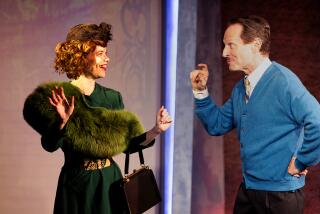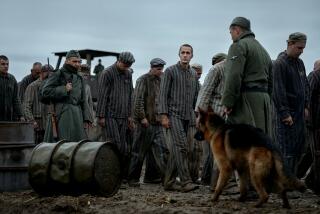‘BERLIN EXILES SERIES’ UNCOVERS A GEM
- Share via
The best part of the County Museum of Art’s Berlin Exiles series is that it has presented so many unfamiliar films instead of the well-known classics of Germany’s Golden Age in the ‘20s. The series concludes at 8 p.m. Wednesday in Bing Theater with a real discovery, Werner Hochbaum’s “Razzia in St. Pauli” (1932), a captivating work of poetic realism set in Hamburg’s raffish St. Pauli district and as evocative as “Berlin, Symphony of a City.”
Heavily fatalistic (and socially conscious), it tells of a brief encounter between a dance-hall girl (Gena Falckenberg) and a rugged seaman (Ernst Busch) on the lam. In Hollywood, the roles could have been played by Sylvia Sidney and Guinn (Big Boy) Williams. In contrast to early American talkies, “Razzia in St. Pauli” is richly scored. Playing with it is the delightful “Woman’s Awakening,” a 1927 silent romance between a young Berlin couple of different classes.
Although “The Jazz Singer” heralded the coming of sound and “Becky Sharp” the advent of the three-strip color feature, experiments in both date back almost to the beginning of the movies themselves. Some of these experiments have been restored and will screen at 7:30 p.m. Wednesday in Melnitz Theater as part of UCLA’s Archival Treasures series.
Wednesday’s offering is one of the most intriguing in the series. The color experiments range from soft pastel effects to early Crayola, all with a quaint charm. Imagine seeing the toast of the Gay ‘90s, Lillian Russell, preening for the camera and dripping with jewels, only a year before her death in 1922. Plump but still pretty at 60, Russell is first seen in black and white, then in footage beautifully tinted (by archives director of preservation Robert Gitt). The sound portion of the program contains inventor Orlando Kellum’s experiments in recording sound acoustically on discs, which were then played back on a phonograph in exact synchronization with the projector through the use of electromagnets.
Although fascinating for what they are and what they portended, there’s absolutely nothing cinematic in Kellum’s shorts, which feature personages of the day speaking into the camera (among them D. W. Griffith and humorist Irvin S. Cobb) and such performers as Sam Moore and His Singing Saw doing their stuff (and giving, inadvertently, ample evidence of why vaudeville died).
This 70-minute offering will be followed by “Tempest” (1928), starring John Barrymore.
“Before ‘Rashomon’: Japanese Film Treasures of the 1930s and ‘40s” continues at 7:30 p.m. Thursday at UCLA Melnitz with Hiroshi Shimizu’s two-part 1939 masterpiece, “The Four Seasons of Children,” which tells of a crucial year in the life of two little brothers. A paean to rural life and to childhood in all its innocence, it is such a subtle film that it takes a while to cast its spell. We see adults in all their strengths and weaknesses through the eyes of the two boys as these elders cope with tragedy and adversity. Shimizu is a master of the expressive long shot and the tracking shot, and “The Four Seasons of Children” unfolds amid beautiful landscapes. In his affectionate understanding of children, Shimizu is easily the equal of Truffaut.
Most of the films of Marlene Dietrich are so familiar that they scarcely need introduction, but it’s worth pointing out that the eight films she made with director Josef Von Sternberg will be shown in the County Museum of Art’s upcoming Dietrich series in their original nitrate prints--no small plus, considering Sternberg’s mastery of light and shadow. The tribute begins at 8 p.m. Friday in Bing Theater with “The Blue Angel” and “Morocco”; Saturday’s double feature will be “Shanghai Express” and “Dishonored.” For ticket and program information: 857-6201.
More to Read
The biggest entertainment stories
Get our big stories about Hollywood, film, television, music, arts, culture and more right in your inbox as soon as they publish.
You may occasionally receive promotional content from the Los Angeles Times.










